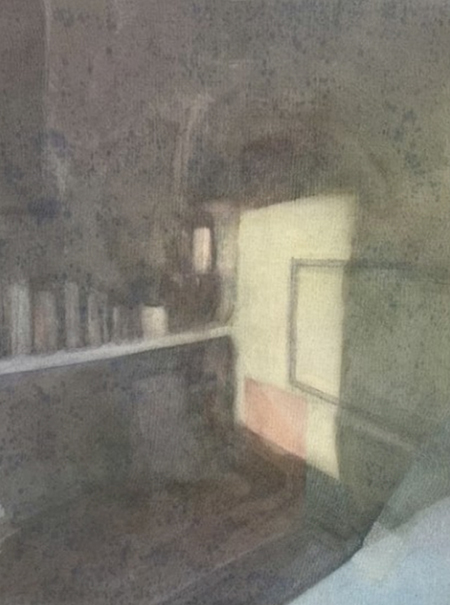
Continuing through December 23, 2023
Josephine Taylor’s new paintings are highly nuanced. They elicit the kind of absorbed examination that one rarely encounters in this post-cellphone era. They remind me of what can still be accomplished when the subtleties of how an image comes into being moves as far into the forefront of that image’s identity as subject matter. In other words, Taylor’s paintings whisper with poetic evocation. They contradict the overcompensating art world that shouts too loudly. They direct themselves to those with minds quiet enough to see visual becomingness (or visual dissolution). Taylor’s paintings represent an important alternative to an obvious and braying there-ness undertaken to take up space but doing nothing with it.
My use of the term ‘visual becomingness’ is intended as a shorthand for the oldest, Platonic definition of the word aesthetic, then revived in the eighteenth century by Alexander Baumgarten. That definition runs something like this: Preapprehension before comprehension. Or to get Kantian about it, intuiting a presence prior to being fully aware of what it is. Taylor’s paintings exemplify this idea. They are nuanced engagements with and expansions of the imaginative space between slipstream phenomena and the noumena that lurks just beyond the veil of knowledge.
The fifteen paintings in the exhibition are all from 2023, dividing into three groups. One of these is a quartet of large works that tease and defy the eye to make sense of them. The largest is titled “Pareidolia at Night,” revealing itself as a hallucinatory pattern that gradually comes into focus as an evanescent image of a woman sleeping amidst patterned blankets. The image is painted on unprimed cotton canvas formed of layers of blue indigo extracted from denim, painstakingly stained into the canvas fabric. This process accounts for the ghost-like quality of the image, which can be compared to the dissolution of an over-developed photograph.
Another group is a trio of darker images sporting a much more pronounced light/dark contrast. They look at first glance like pre-digital cyanotypes, or to us old timers, drawings created with inexpensive bluing rather than overpriced ink. They too are made from layers of indigo extracted from denim fabric, the darker blue resulting from more layers of saturated application. From layer to layer, an unstable dither effect emerges, looking intentionally misaligned in a way reminiscent of the photographs of Wolfgang Tillmans.
The smallest works here comprise a more forthright third group, even though they also use the saturation into unprimed canvas technique. The difference is that, in the case of these works, there is a wider range of color suggestive of other fabrics. Also, they make a more directly explicit correspondence to imagistic description. For example, “Desk” reads clear enough as a yellow frame of light positioned at an oblique angle in a dark room that does feature a desk. It doesn’t take much of a leap to envision it as an angular geometric construction floating in Constructivist space.
Taylor’s use of the staining technique harks to the work of 1950s-era stain painters such as Morris Louis. However, Taylor moves it in a very different direction from the historically mined explorations of translucent veils of fluid color. To be sure, in the case of both artists’ work, the pigment saturates unprimed fabric in ways that generate a glowing, iridescent effect. However, in Taylor’s paintings there is a delayed return to representation after the long detour into and through the material and processes that eventually gives rise to the representation. This seems to be a crucial point: whether or not a painting works toward, or from, or with any image, it is always something more than that image. That additional attribute can be described as a way of finding one’s path to and from the image without letting that image dominate and over-determine how one experiences its meaning. This is the point that Taylor’s “Night House” paintings make with equal measures of power and subtlety.
